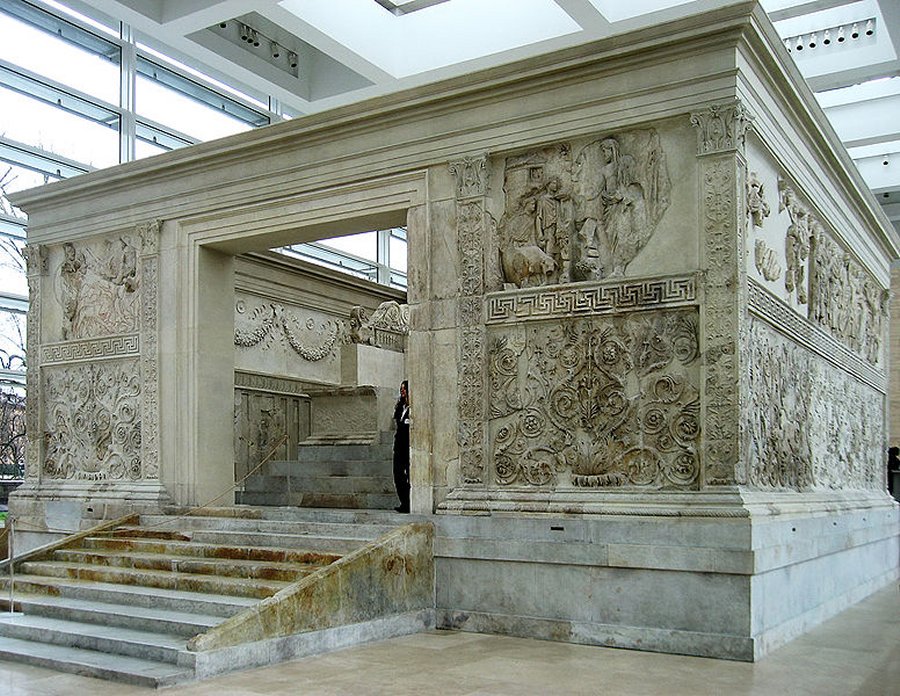Ara Pacis: Altar In Rome Dedicated To Pax, The Roman Goddess Of Peace
A. Sutherland - AncientPages.com - The Ara Pacis, or Altar of the Augustan Peace, in Rome, was built to celebrate the return of Augustus (63 BC – 14 CE) from his campaigns in Spain and Gaul.
Augustus was the first and - by all accounts – greatest emperor of Rome.
The 3 m tall altar stands on a 6 x 7 m podium and is richly decorated and was consecrated on July 4, 13 BC and dedicated on January 30, 9 BC, the birthday of his wife, Livia. The U-shaped altar was inside a precinct, open to the sky with one staircase and double doors. Image credit: Manfred Heyde - CC BY-SA 3.0
The marble structure, which once stood on the Campus Martius, is a masterpiece of Roman sculpture, particularly of beautiful and vivid portraits. Wonderful skills of the Roman artisans dominate when we are looking at their mastework.
Indeed, the altar is an exquisite work of art, richly decorated with Vine ornaments and a detailed figured frieze, which depicts a sacrificial act, in which the imperial family and the most important priests participate. There are also mythical representations of the goddess Roma, the twins Romulus and Remus suckling the She-Wolf, Aeneas and Mother Earth, represented as a symbol of peace.
Senators, officials, and the Imperial family are depicted on the wall reliefs of the monument in an animated people's procession that welcome the emperor's return.
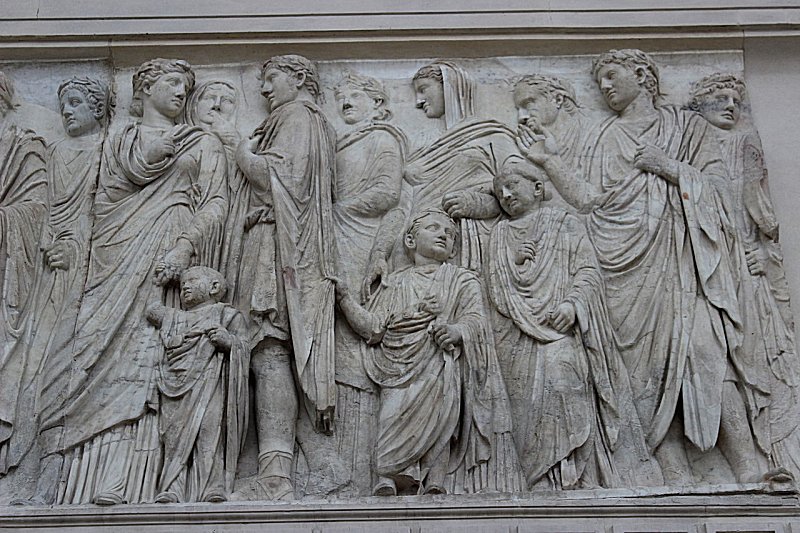 Ara Pacis relief. Image credit: Miguel Hermoso Cuesta - CC BY-SA 3.0
Ara Pacis relief. Image credit: Miguel Hermoso Cuesta - CC BY-SA 3.0
Augustus recorded the altar's construction in his "Deeds of the Divine Augustus" (Ris gestae), revealing important details: when and why it was consecrated and where it was built.
The 3 m tall altar stands on a 6 x 7 m podium and is richly decorated and was consecrated on July 4, 13 BC and dedicated on January 30, 9 BC, the birthday of his wife, Livia. The U-shaped altar was inside a precinct, open to the sky with one staircase and double doors.
Historical, legendary, mythological, sacrificial, and decorative reliefs adorn the inner and outer walls. The relief figures include Augustus and the Imperial family, officials such as magistrates, senators, priests, and their families. All are captured in a single moment as they participate in a procession.
Initially, the altar complex consisted of an interior altar surrounded by a stone precinct wall. The whole structure was raised on a marble platform with steps leading into the precinct.
The Ara Pacis were heavily ornamented with relief carving. The visual images and symbols are often associated with fertility and prosperity, in the form of vegetation and animals, depicted in the masterwork's lower register. In the upper, there are scenes depicting Rome’s mythic past.
Altar of Augustan Peace - Ara Pacis Augustae. (left) A member of the Priestly college of Septemviri epulones, carries an incense box, processional scene (north side), 9 B.C. Ara Pacis Museum, Rome, Image credit: Steven Zucker, CC BY-NC-SA 2.0
The Ara Pacis appeared on the coins of Nero between 64 and 67 CE. Various altarpieces were re-discovered in c. 1568, 1859, and 1903 CE and later during excavations between 1937 and 1938 CE.
The monument was restored on a new site in the 20th century. The altar fragments, stored in several European museums, were collected together and the altar reassembled. The Ara Pacis is almost complete and stands in the Museo dell'Ara Pacis, next to the Mausoleum of Augustus in Rome.
Written by – A. Sutherland - AncientPages.com Senior Staff Writer
Updated on September 9, 2022
Copyright © AncientPages.com All rights reserved. This material may not be published, broadcast, rewritten or redistributed in whole or part without the express written permission of AncientPages.com
Expand for referencesReferences:
Nancy Thomson de Grummond (edited), Encyclopedia of the History of Classical Archaeology
E. E. Kleiner, Roman Architecture: A Visual Guide
More From Ancient Pages
-
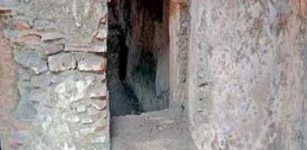 1,200-Year-Old Rock-Cut Temple Found On Banks Of Arjuna River,Tamil Nadu, India
Archaeology | Sep 3, 2020
1,200-Year-Old Rock-Cut Temple Found On Banks Of Arjuna River,Tamil Nadu, India
Archaeology | Sep 3, 2020 -
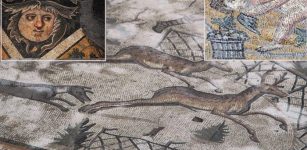 Beautiful Mosaics In Ancient City Of Germanicia
Archaeology | Sep 17, 2020
Beautiful Mosaics In Ancient City Of Germanicia
Archaeology | Sep 17, 2020 -
 Félag – Ancient Viking Company Organized Trade Finance
Ancient History Facts | May 4, 2018
Félag – Ancient Viking Company Organized Trade Finance
Ancient History Facts | May 4, 2018 -
 Urban Resiliency Lie Within Ancient Cities – New Study Suggests
Archaeology | Jul 25, 2023
Urban Resiliency Lie Within Ancient Cities – New Study Suggests
Archaeology | Jul 25, 2023 -
 Kallikantzaroi: Naughty Nocturnal Goblins Emerge From Underground Only During Twelve Days Of Christmas
Christmas Traditions | Dec 17, 2019
Kallikantzaroi: Naughty Nocturnal Goblins Emerge From Underground Only During Twelve Days Of Christmas
Christmas Traditions | Dec 17, 2019 -
 Archaeological Mystery Of Laos Megalithic Jars Continues – New Attempt To Solve The Riddle
Archaeology | Mar 12, 2021
Archaeological Mystery Of Laos Megalithic Jars Continues – New Attempt To Solve The Riddle
Archaeology | Mar 12, 2021 -
 Mystery Of Giant Gogmagog’s Hidden Treasure Beneath Castell Dinas Bran
Featured Stories | Oct 15, 2021
Mystery Of Giant Gogmagog’s Hidden Treasure Beneath Castell Dinas Bran
Featured Stories | Oct 15, 2021 -
 Little Known History Of Amazon’s Ashaninka People Studied By Researchers
Archaeology | Mar 21, 2023
Little Known History Of Amazon’s Ashaninka People Studied By Researchers
Archaeology | Mar 21, 2023 -
 Ancient Race Of Star Worshippers And Secret Message Stored In Unusual Monument
Civilizations | Jun 11, 2018
Ancient Race Of Star Worshippers And Secret Message Stored In Unusual Monument
Civilizations | Jun 11, 2018 -
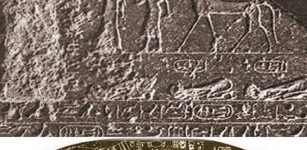 Ancient Stela Of Piankhi – King Of Napata, Rightful Ruler And Maintainer Of Maat
Featured Stories | Apr 25, 2018
Ancient Stela Of Piankhi – King Of Napata, Rightful Ruler And Maintainer Of Maat
Featured Stories | Apr 25, 2018 -
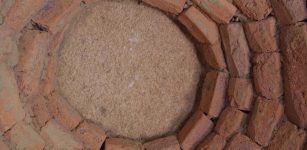 Smallest Ancient Thracian Brick Tomb – Discovered In Bulgaria
Archaeology | Oct 6, 2018
Smallest Ancient Thracian Brick Tomb – Discovered In Bulgaria
Archaeology | Oct 6, 2018 -
 Unexplained Disappearance Of East Balkan Civilizations – Discovery Of Unusual Mini Artifacts – Part 1
Civilizations | Apr 28, 2018
Unexplained Disappearance Of East Balkan Civilizations – Discovery Of Unusual Mini Artifacts – Part 1
Civilizations | Apr 28, 2018 -
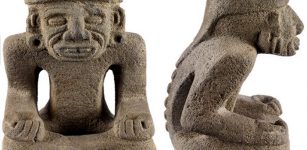 Huehueteotl: Old Aztec God Of Fire, Time And Aging – Ceremony Of The New Fire
Aztec Mythology | Jan 31, 2019
Huehueteotl: Old Aztec God Of Fire, Time And Aging – Ceremony Of The New Fire
Aztec Mythology | Jan 31, 2019 -
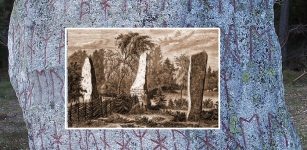 Björketorp Runestone With An Engraved Curse Is Still Untouched In Blekinge, Sweden
Featured Stories | Mar 19, 2023
Björketorp Runestone With An Engraved Curse Is Still Untouched In Blekinge, Sweden
Featured Stories | Mar 19, 2023 -
 Never Explained Mystery Of Star-Shaped Towers Of The Himalayas
Featured Stories | Nov 24, 2014
Never Explained Mystery Of Star-Shaped Towers Of The Himalayas
Featured Stories | Nov 24, 2014 -
 Mysterious Figurine Of Mythical Individual Dates Back To Egypt’s Naqada Culture 4400–3000 BC
Featured Stories | Sep 25, 2016
Mysterious Figurine Of Mythical Individual Dates Back To Egypt’s Naqada Culture 4400–3000 BC
Featured Stories | Sep 25, 2016 -
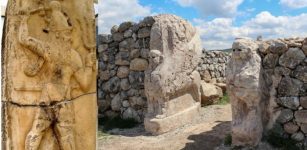 Code Of Nesilim: Ancient Laws Of The Hittites
Ancient History Facts | Jun 14, 2018
Code Of Nesilim: Ancient Laws Of The Hittites
Ancient History Facts | Jun 14, 2018 -
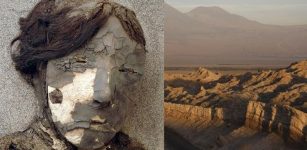 Mystery Of The Chinchorro Civilization And The World’s Oldest Mummies
Civilizations | Dec 27, 2016
Mystery Of The Chinchorro Civilization And The World’s Oldest Mummies
Civilizations | Dec 27, 2016 -
 Why Is The Hungry Ghost Festival Celebrated In August?
Ancient Traditions And Customs | Aug 12, 2019
Why Is The Hungry Ghost Festival Celebrated In August?
Ancient Traditions And Customs | Aug 12, 2019 -
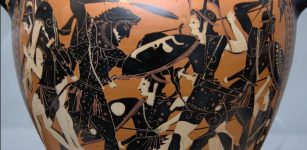 Did The Amazons Really Exist? – Truth Behind Myths Of Fierce Female Warriors
Featured Stories | Oct 29, 2014
Did The Amazons Really Exist? – Truth Behind Myths Of Fierce Female Warriors
Featured Stories | Oct 29, 2014

